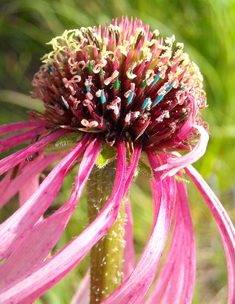
E. pallida heads are easily distinguished from E. angustifolia by their white pollen and longer ray florets.
Echinacea pallida, an Echinacea species compatible with E. angustifolia, but not native to our study area, was planted at a restoration at Hegg Lake WMA. One trait of E. pallida may limit its potential to hybridize with E. angustifolia individuals is the synchrony of their flowering timing, or phenology. To study this, we have kept track of the start and end dates of flowering for Echinacea pallida individuals in the Hegg restoration plot since 2011. In 2016, we identified 66 flowering plants with 113 heads. Flowering began on June 18th. Then, around July 7th, we chopped off all the Echinacea pallida heads.
Start year: 2011
Location: Hegg Lake WMA restoration
Overlaps with: Echinacea hybrids (exPt6, exPt7, exPt9), flowering phenology in remnants
Physical specimens: 113 heads were cut from E. pallida plants circa 7 July 2016 (the last day of recorded phenology). These specimens were likely composted.
Data collected: We collected phenology data using handheld computers.
GPS points shot: We shot points for the 66 flowering E. pallida plants.
Products: In Fall 2013, Aaron and Grace, externs from Carleton College, investigated hybridization potential by analyzing the phenology and seed set of Echinacea pallida and neighboring Echinacea angustifolia that Dayvis collected in summer 2013. They wrote a report of their study.
Previous team members who have worked on this project include: Nicholas Goldsmith (2011), Shona Sanford-Long (2012), Dayvis Blasini (2013), and Cam Shorb(2014)
You can find more information about Echinacea pallida flowering phenology and links to previous flog posts regarding this experiment at the background page for the experiment.

Leave a Reply